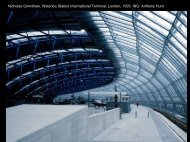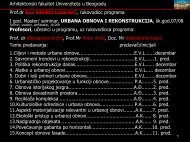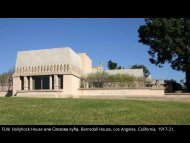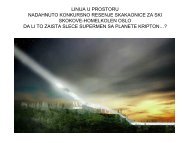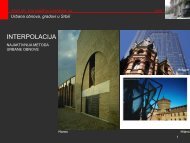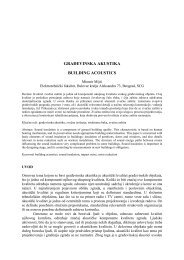Architecture and Ideology
Architecture and Ideology
Architecture and Ideology
You also want an ePaper? Increase the reach of your titles
YUMPU automatically turns print PDFs into web optimized ePapers that Google loves.
94<br />
Dr LJILJANA BLAGOJEVIĆ, Associate Professor<br />
Faculty of <strong>Architecture</strong>, University of Belgrade, ljblagojevic@arh.bg.ac.rs<br />
THE MODERN CITY RECONFIGURED<br />
POST‐SOCIALIST TRANSFORMATION OF NEW BELGRADE<br />
Abstract |<br />
The paper explores post‐socialist transformation of New Belgrade (Serbia) which unfolds<br />
against the extant modern urban l<strong>and</strong>scape of the new city constructed during the period of<br />
socialism. New Belgrade was realized as a modern, functional city of socialist collective housing<br />
in societal property, with very limited internal economic dynamics. The last two decades of<br />
post‐socialist socio‐political <strong>and</strong> economic transition have unleashed the dynamic processes of<br />
change such as depoliticization, privatization, gentrification, commoditization <strong>and</strong><br />
desecularization of urban space. With almost no historic preservation of modernist<br />
architecture <strong>and</strong> urban plan, the under‐urbanized structure of New Belgrade allowed for far<br />
more efficient development than the spatially <strong>and</strong> legislatively constricted historical centre.<br />
Development programs are those deemed to have been lacking in the socialist epoch, from<br />
churches <strong>and</strong> up‐market residential, to business <strong>and</strong> commerce, retail <strong>and</strong> leisure, banking <strong>and</strong><br />
gambling. In the context of eminently ideological anti‐socialist/communist discourse, the space<br />
of the modern city is often reductively seen as the physical residue of the deposed socio‐<br />
economic <strong>and</strong> political system, or as its ideological monument. Thus ideologically stigmatized,<br />
modern urban l<strong>and</strong>scape is either left to decay or subsumed by the rapidly developing space of<br />
globalization. Some recent studies present the current processes of urban change in bright <strong>and</strong><br />
positive light of an eagerly awaited progress towards market economy, while others see the<br />
paramount importance of protection <strong>and</strong> preservation of modernist architectural heritage. Can<br />
it be argued that the balance between the two is to be found in sustainable development<br />
strategies which appreciate New Belgrade's specificity of modern city urban l<strong>and</strong>scape <strong>and</strong> its<br />
waterscape?<br />
Key words |<br />
New Belgrade, modern city, post‐socialist city, urban l<strong>and</strong>scape, sustainability, green‐blue<br />
network




